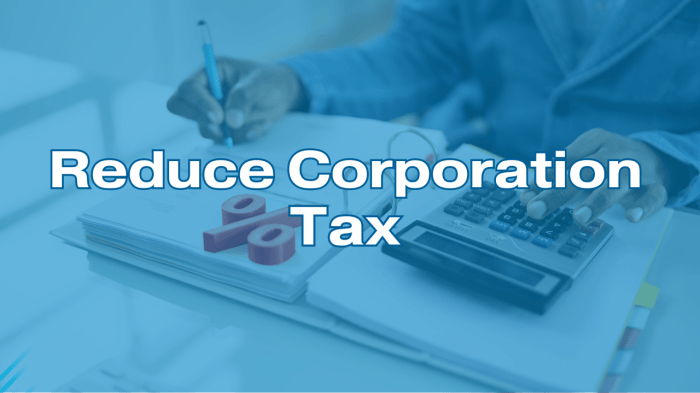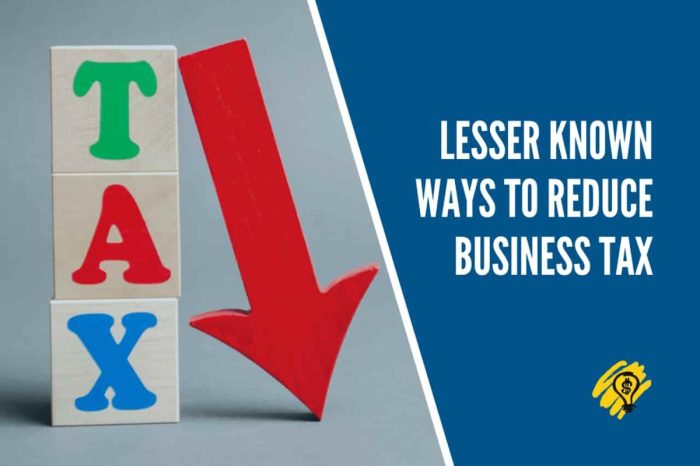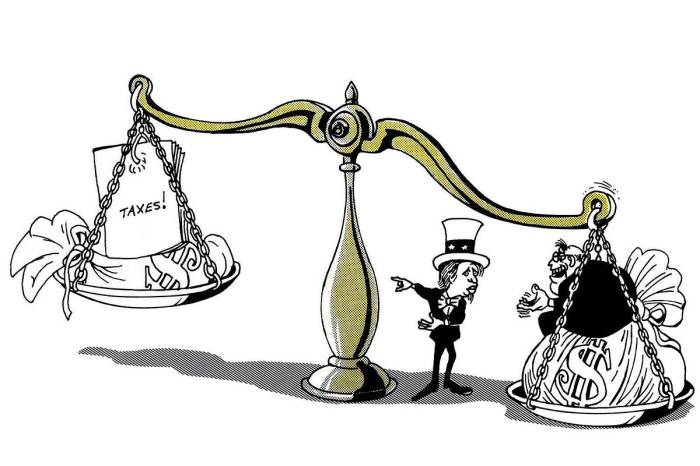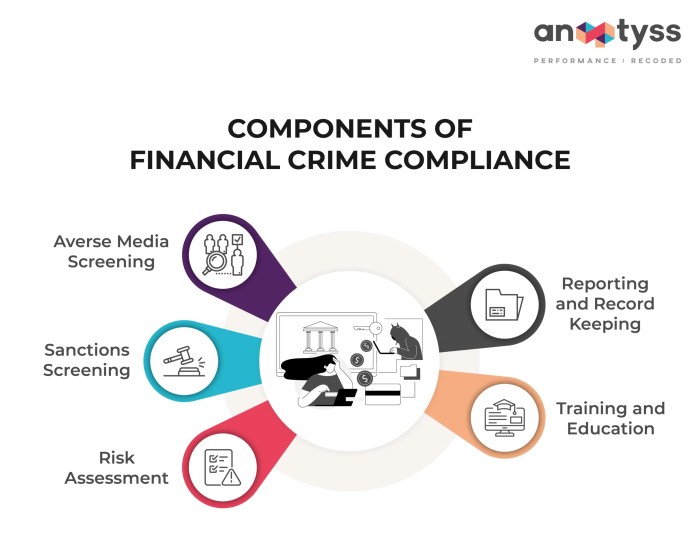How to Reduce Business Taxes Legally is a crucial topic for any business owner seeking to maximize profitability. This guide explores various legal strategies to minimize your tax burden, from understanding deductions and credits to optimizing your business structure and leveraging tax-advantaged investments. We’ll delve into practical techniques and provide actionable insights to help you navigate the complexities of business taxation and achieve significant tax savings.
Successfully managing your business taxes requires a proactive and strategic approach. This involves not only understanding the tax laws but also implementing effective planning throughout the year. This guide will equip you with the knowledge and tools necessary to make informed decisions and optimize your tax situation legally and efficiently. We will cover a wide range of topics, including tax deductions, credits, business structures, and the importance of professional guidance. By the end, you will be better positioned to navigate the tax landscape and reduce your business’s tax liability.
Understanding Tax Deductions: How To Reduce Business Taxes Legally
Tax deductions are a powerful tool for reducing your business’s tax liability. By understanding the various deductions available and how to claim them correctly, you can significantly lower your tax burden and improve your bottom line. This section will explore different types of deductions, provide examples, and Artikel the process of claiming them on your tax return.
Types of Business Tax Deductions
Numerous tax deductions are available to businesses, depending on their structure and activities. These deductions generally fall into categories reflecting common business expenses. Careful record-keeping is crucial for maximizing deductions.
Common Deductible Expenses for Small Businesses
Many expenses incurred in running a small business are deductible. These can significantly reduce taxable income. Accurate record-keeping is essential to support these deductions during an audit.
| Expense Type | Description | Example | Benefit |
|---|---|---|---|
| Office Expenses | Costs associated with maintaining a workspace. | Rent, utilities, stationery, internet service. | Reduces taxable income directly. |
| Travel Expenses | Costs incurred for business travel. | Airfare, lodging, mileage, meals (partially deductible). | Offsets travel costs associated with business activities. |
| Depreciation | The gradual reduction in the value of assets over time. | Depreciation of equipment, vehicles, or buildings. | Spreads the cost of assets over their useful life, reducing annual tax burden. |
| Salaries and Wages | Compensation paid to employees. | Wages, salaries, benefits (health insurance, retirement contributions). | Reduces taxable income; some benefits are also deductible. |
Claiming Deductions on Tax Returns
The process of claiming deductions involves accurately recording all eligible expenses throughout the year. Maintaining detailed records, such as receipts, invoices, and bank statements, is essential. This documentation supports the claimed deductions during a tax audit. These records should be organized by category for efficient tax preparation. The specific forms and schedules used will vary depending on the business structure and the type of deductions claimed. Consulting with a tax professional is advisable to ensure compliance and maximize deductions.
Comparison of Deduction Benefits and Limitations
Different deductions offer varying benefits and limitations. Understanding these nuances is critical for making informed financial decisions.
| Deduction Type | Benefits | Limitations | Example |
|---|---|---|---|
| Home Office Deduction | Reduces taxable income by deducting a portion of home expenses. | Strict requirements for qualifying space; must be exclusively used for business. | A freelancer using a dedicated room as their office. |
| Charitable Contributions | Reduces taxable income while supporting worthwhile causes. | Limitations on the amount deductible; must be to qualified organizations. | Donation to a registered charity. |
| Self-Employment Tax Deduction | Reduces self-employment tax liability. | Only applicable to self-employed individuals. | A sole proprietor deducting half of their self-employment tax. |
| Qualified Business Income (QBI) Deduction | Deducts a portion of qualified business income. | Income limitations and specific rules apply. | A small business owner deducting a percentage of their business profits. |
Tax Credits for Businesses
Tax credits offer a powerful way for businesses to reduce their tax liability, often providing a dollar-for-dollar reduction in taxes owed, unlike deductions which only reduce taxable income. Understanding the various tax credits available and meeting the eligibility requirements is crucial for maximizing tax savings. This section will explore several key tax credits, categorized by industry and size, highlighting eligibility criteria and providing real-world examples of their successful application.
Types of Business Tax Credits
Businesses can access a wide array of tax credits, depending on their industry, size, and activities. These credits often incentivize specific behaviors, such as investing in research and development, hiring employees from disadvantaged groups, or making energy-efficient improvements. The availability and specifics of these credits can change, so it’s crucial to consult the latest IRS publications and seek professional tax advice.
Research and Development Tax Credit (R&D Credit)
The R&D tax credit is available to businesses of all sizes that incur qualified research expenses. These expenses include salaries, supplies, and contract research costs associated with developing new or improved products, processes, or software. Eligibility hinges on the nature of the research activities – they must be aimed at discovering new technological information, and the process must involve a process of experimentation. A small software company developing a new algorithm for data analysis would qualify, as would a large manufacturing firm developing a new, more efficient production process. For example, a hypothetical company, “InnovateTech,” successfully used the R&D credit to offset a significant portion of its expenses related to developing a groundbreaking new medical device, substantially reducing its tax liability.
Work Opportunity Tax Credit (WOTC)
The WOTC incentivizes businesses to hire individuals from specific target groups, such as veterans, ex-offenders, and long-term unemployed individuals. Eligibility requires the employer to meet specific hiring requirements and file the required forms with the IRS. A restaurant chain, for instance, might utilize the WOTC by hiring individuals from disadvantaged backgrounds, reducing its tax burden while contributing to social responsibility. The credit amount varies depending on the employee’s characteristics and the duration of their employment.
Energy Efficient Tax Credits
Numerous tax credits exist to encourage businesses to invest in energy-efficient technologies and practices. These credits often target specific improvements, such as installing solar panels, improving insulation, or upgrading to more efficient heating and cooling systems. Eligibility typically involves meeting specific energy-efficiency standards. A small retail business installing energy-efficient lighting could qualify, as could a large manufacturing plant implementing a comprehensive energy management system. A hypothetical example: “Green Solutions Inc.,” a sustainable building company, used the energy efficient tax credit to offset the costs of installing solar panels on their new office building. This reduced their tax burden significantly while showcasing their commitment to sustainability.
Application Process for the R&D Tax Credit: A Flowchart
The application process for the R&D tax credit involves several steps. The flowchart below illustrates a simplified version of this process:
[Imagine a flowchart here. The flowchart would start with “Determine Eligibility for R&D Credit,” branching to “Yes” (proceed to next step) and “No” (end). The “Yes” branch would lead to “Calculate Qualified Research Expenses,” then to “Complete Form 6765,” then to “Attach supporting documentation,” and finally to “File with tax return.” The “No” branch would simply end.]
Optimizing Business Structure for Tax Efficiency
Choosing the right business structure is crucial for minimizing your tax burden. The structure you select dictates how your business’s profits and losses are reported on your personal income tax return, impacting your overall tax liability. Different structures offer varying levels of liability protection and administrative complexities, all of which must be weighed against potential tax savings.
Tax Implications of Different Business Structures
The tax implications vary significantly depending on whether your business is a sole proprietorship, partnership, LLC, S-corporation, or C-corporation. Sole proprietorships and partnerships, for example, have a pass-through taxation system, meaning profits and losses are reported on the owners’ personal income tax returns. Conversely, LLCs, S-corps, and C-corps have more complex structures with distinct tax implications. Understanding these differences is essential for making an informed decision.
- Sole Proprietorship: Profits and losses are reported on the owner’s personal income tax return (Schedule C). Simple to set up, but offers no liability protection.
- Partnership: Similar to a sole proprietorship in that profits and losses are passed through to the partners’ personal returns. Requires a partnership agreement, offering some liability protection depending on the agreement’s terms.
- Limited Liability Company (LLC): Offers liability protection while providing flexibility in taxation. LLCs can be taxed as sole proprietorships, partnerships, S-corporations, or C-corporations, depending on election made with the IRS.
- S-Corporation: Profits and losses are passed through to the shareholders’ personal income tax returns. Offers liability protection and can potentially lead to lower self-employment taxes compared to other pass-through entities, particularly for higher-income owners.
- C-Corporation: A separate legal entity taxed independently of its owners. Profits are taxed at the corporate level, and dividends paid to shareholders are taxed again at the individual level (double taxation). Offers strong liability protection but generally incurs higher tax burdens.
Comparing and Contrasting Tax Benefits and Drawbacks
Each business structure presents a unique balance of tax benefits and drawbacks. The optimal choice depends on factors like income level, risk tolerance, and long-term business goals.
| Structure | Tax Benefits | Tax Drawbacks |
|---|---|---|
| Sole Proprietorship | Simplicity, easy setup | Unlimited liability, higher self-employment taxes |
| Partnership | Pass-through taxation, relatively easy setup | Unlimited liability (for general partners), potential for disputes |
| LLC | Liability protection, flexibility in taxation | Complexity in choosing the right tax structure |
| S-Corporation | Liability protection, potential for lower self-employment taxes | More complex setup and administrative requirements |
| C-Corporation | Strong liability protection | Double taxation (corporate and individual levels), complex administrative requirements |
Step-by-Step Guide to Choosing the Optimal Business Structure
Choosing the right business structure requires careful consideration. Here’s a step-by-step guide:
- Assess your risk tolerance: How much personal liability are you willing to accept?
- Project your income: Higher incomes may benefit from the tax advantages of an S-corp or LLC taxed as an S-corp.
- Consider long-term goals: Do you plan to seek outside investment? A C-corp might be more suitable.
- Consult with a tax professional: A qualified accountant or tax attorney can provide personalized advice based on your specific circumstances.
- Formalize your choice: File the necessary paperwork with the relevant authorities to establish your chosen business structure.
Key Factors to Consider When Choosing a Business Structure
Several key factors should influence your decision. Failing to consider these aspects may lead to suboptimal tax outcomes.
- Liability Protection: The level of personal liability you’re willing to assume for business debts.
- Tax Rates: The effective tax rate under different structures given your projected income.
- Administrative Burden: The complexity of maintaining records and complying with regulatory requirements.
- Future Funding: The ease of attracting investors or securing loans under the chosen structure.
- Long-Term Growth: The scalability of the structure to accommodate future expansion.
Strategic Tax Planning for Businesses

Proactive tax planning is crucial for businesses of all sizes. It’s not just about minimizing your tax bill at the end of the year; it’s about strategically managing your finances throughout the year to optimize your tax position and maximize profitability. A well-defined tax strategy can significantly impact your bottom line, allowing for reinvestment and growth.
The Importance of Proactive Tax Planning Throughout the Year
Effective tax planning isn’t a one-time event; it’s an ongoing process. Regularly reviewing your financial situation, anticipating upcoming tax liabilities, and adjusting your strategies accordingly is key. This proactive approach allows for better cash flow management, minimizes surprises at tax time, and enables you to take advantage of tax-saving opportunities as they arise. For example, quarterly tax payments based on estimated income help avoid large lump-sum payments at year-end. Similarly, consistently tracking deductible expenses throughout the year ensures you don’t miss claiming legitimate deductions.
Strategies for Managing Cash Flow to Minimize Tax Liability
Careful cash flow management is paramount for minimizing tax liabilities. Strategies include optimizing your payment schedules to align with tax deadlines, investing in tax-advantaged accounts, and strategically timing significant purchases or investments to leverage tax deductions. For instance, deferring income to a later tax year when your tax bracket might be lower can reduce your overall tax burden. Conversely, accelerating deductions into the current year when you’re in a higher tax bracket can offer immediate tax savings.
Tax Planning Techniques for Different Business Stages
Tax planning strategies should adapt to the specific stage of your business lifecycle.
Startup businesses often focus on maximizing deductions related to startup costs and expenses. This might include deducting a portion of home office expenses, business-related travel, and professional fees. Growth-stage businesses may prioritize strategies to minimize taxes on increased profits, potentially exploring options like accelerated depreciation or tax credits for research and development. Mature businesses, with established income streams, might concentrate on long-term tax planning, such as estate planning and succession strategies to minimize tax implications for future generations.
Hypothetical Business Scenario and Tax Planning Impact
Let’s consider “GreenThumb Gardens,” a landscaping business. In its first year (startup), GreenThumb incurred significant startup costs, including purchasing equipment and establishing a business presence. By strategically claiming these expenses as deductions, they significantly reduced their taxable income. As GreenThumb grows (growth stage), they reinvest profits into expanding their operations. They utilize accelerated depreciation to deduct the cost of new equipment more quickly, reducing their taxable income in the early years. In its maturity stage, GreenThumb establishes a retirement plan for its employees, reducing its taxable income while providing employee benefits. Through strategic tax planning at each stage, GreenThumb minimized its overall tax burden and maximized its profitability, enabling reinvestment and long-term growth. Without this proactive planning, their tax liability could have been significantly higher, potentially hindering their growth trajectory.
Utilizing Tax Software and Professionals

Navigating the complexities of business taxes can be daunting, even for seasoned entrepreneurs. Fortunately, leveraging technology and expert advice can significantly streamline the process and lead to greater tax efficiency. This section explores the benefits of utilizing both tax software and the expertise of qualified tax professionals.
Tax software and professional tax advice are complementary tools, each offering unique advantages in managing your business’s tax obligations. Effective utilization of both can minimize errors, optimize deductions, and ensure compliance with all relevant tax laws.
Benefits of Tax Software for Accurate Tax Preparation
Tax preparation software offers several advantages, primarily its ability to automate many aspects of tax filing. These programs typically include built-in checks to identify potential errors and omissions, reducing the likelihood of penalties and audits. Furthermore, many software packages offer features that help businesses track income and expenses throughout the year, simplifying the year-end tax preparation process. This proactive approach facilitates more accurate reporting and helps avoid last-minute scrambling. The software’s ability to handle complex calculations also minimizes the risk of mathematical errors. The user-friendly interfaces of many programs make them accessible even to those with limited accounting experience, although professional guidance remains valuable for complex scenarios.
The Role of Tax Professionals in Optimizing Tax Strategies
While tax software provides valuable assistance, the expertise of a qualified tax professional is invaluable for developing and implementing comprehensive tax strategies. Accountants and Certified Public Accountants (CPAs) possess in-depth knowledge of tax laws and regulations, enabling them to identify opportunities for deductions and credits that might be overlooked using software alone. They can also advise on the most tax-efficient business structure, assist with tax planning throughout the year, and represent businesses during audits. Their expertise extends beyond simple tax preparation; they provide strategic guidance to minimize tax liability while remaining fully compliant. For example, a CPA can help structure business transactions in a way that minimizes tax impact or advise on investment strategies that offer tax advantages.
Comparison of Different Tax Software Options for Businesses
The market offers a range of tax software options catering to businesses of various sizes and complexities. Some popular choices include QuickBooks Online, Xero, and TurboTax Business. QuickBooks Online, for example, integrates accounting and tax functions, providing a comprehensive solution for managing finances. Xero offers similar functionality with a strong focus on cloud-based accessibility. TurboTax Business is designed specifically for tax preparation and offers a range of features, from basic filing to more advanced tax planning tools. The optimal choice depends on factors such as business size, complexity of financial transactions, and budget. It is crucial to research and compare features, pricing, and user reviews before selecting a software solution. Consider factors such as ease of use, integration with existing accounting systems, and the level of support provided.
Criteria for Selecting a Qualified Tax Professional
Choosing the right tax professional is critical. Look for a CPA or an accountant with proven experience in working with businesses similar to yours. Verify their credentials and professional licenses. Check online reviews and testimonials to gauge their reputation and client satisfaction. Inquire about their fees and payment structures upfront to avoid unexpected costs. Consider their communication style and whether they are responsive to your needs. A strong professional relationship built on trust and clear communication is essential for effective tax planning and compliance. Don’t hesitate to ask potential professionals about their experience with specific tax issues relevant to your business, such as deductions for small business expenses or the intricacies of state and local taxes.
Depreciation and Amortization
Depreciation and amortization are crucial accounting methods that allow businesses to deduct the cost of assets over their useful life, reducing their taxable income. Understanding these concepts is vital for minimizing your tax burden legally and efficiently. This section will explain the principles of depreciation and amortization, detailing eligible assets and calculation methods.
Depreciation refers to the systematic allocation of the cost of a tangible asset over its useful life. Amortization, on the other hand, applies to intangible assets. Both methods allow businesses to recover the cost of these assets over time, rather than recognizing the entire expense in the year of purchase. This reduces taxable income in the present and spreads the cost across the asset’s useful life, providing a more accurate representation of a company’s financial performance.
Assets Eligible for Depreciation and Amortization
Depreciation applies to tangible assets with a determinable useful life, such as equipment, machinery, vehicles, and buildings. Amortization, conversely, is used for intangible assets like patents, copyrights, trademarks, and goodwill. The Internal Revenue Service (IRS) provides specific guidelines on which assets qualify and the allowable depreciation or amortization methods. For example, a company purchasing a delivery truck would depreciate its cost over its estimated useful life, while a business acquiring a patent would amortize its cost over its legal protection period.
Methods for Calculating Depreciation and Amortization
Several methods exist for calculating depreciation and amortization, each with its own implications for tax liability. The choice of method can significantly impact the amount of depreciation or amortization expense deducted each year. Common methods include:
- Straight-Line Depreciation: This is the simplest method, allocating an equal amount of depreciation expense each year over the asset’s useful life. The formula is: (Asset Cost – Salvage Value) / Useful Life.
- Accelerated Depreciation: Methods like Double-Declining Balance and Sum-of-the-Years’ Digits allocate a larger portion of depreciation expense in the early years of an asset’s life and a smaller portion in later years. These methods result in higher deductions in the early years, potentially lowering taxable income during those periods.
- Units of Production: This method bases depreciation on the actual use of the asset. It is calculated by determining the depreciation per unit and multiplying it by the number of units produced during the year.
Amortization methods are generally simpler, often using the straight-line method to allocate the cost of an intangible asset evenly over its useful life.
Depreciation Schedule Example
The following table illustrates a simplified depreciation schedule for various assets using the straight-line method. Note that actual depreciation calculations can be more complex, depending on the chosen method, asset type, and IRS guidelines.
| Asset | Cost | Salvage Value | Useful Life (Years) | Annual Depreciation |
|---|---|---|---|---|
| Office Equipment | $10,000 | $1,000 | 5 | $1,800 |
| Delivery Truck | $30,000 | $5,000 | 7 | $3,571 |
| Building | $500,000 | $50,000 | 25 | $18,000 |
| Computer Software | $5,000 | $0 | 3 | $1,667 |
Note: This is a simplified example and does not account for all potential factors influencing depreciation calculations. Consult with a tax professional for accurate and personalized advice.
Investing in Tax-Advantaged Accounts
Investing in tax-advantaged accounts offers significant benefits for business owners seeking to reduce their current and future tax liabilities while simultaneously building wealth for retirement or other financial goals. These accounts allow for pre-tax contributions, reducing taxable income in the present, and often provide tax-deferred growth, meaning taxes are only paid upon withdrawal. Understanding the various options and their associated risks is crucial for effective tax planning.
Retirement Plans for Business Owners
Retirement plans, such as 401(k)s and SEP IRAs, provide powerful tax advantages for business owners. Contributions made to these plans are often tax-deductible, reducing the business’s taxable income. For example, a sole proprietor contributing to a SEP IRA can deduct the contribution amount, directly lowering their tax bill for the year. Additionally, the investment earnings within the plan grow tax-deferred, meaning no taxes are paid on the investment gains until funds are withdrawn in retirement. This compounding effect significantly boosts long-term savings. The specific contribution limits and rules vary depending on the plan type and the owner’s age.
Other Tax-Advantaged Investment Options for Businesses, How to Reduce Business Taxes Legally
Beyond retirement plans, businesses can explore other tax-advantaged investment opportunities. Health savings accounts (HSAs), for instance, allow tax-deductible contributions for eligible individuals with high-deductible health plans. The funds can be used for qualified medical expenses, and any unused funds roll over year to year, accumulating tax-free. Another option is life insurance, where certain types of policies offer tax advantages, such as tax-deferred growth of cash value and potentially tax-free death benefits to beneficiaries. These are just a few examples, and the suitability of each option depends on individual circumstances and financial goals.
Examples of Tax Reduction Through Tax-Advantaged Investments
Consider a small business owner contributing the maximum amount to a SEP IRA. Let’s assume this maximum contribution is $66,000 for a given year. If this owner is in a 25% tax bracket, the tax savings from this deduction would be $16,500 ($66,000 x 0.25). Furthermore, any investment growth within the SEP IRA is tax-deferred, meaning the owner avoids paying taxes on investment gains until retirement. This compounding effect over several decades can lead to substantial long-term tax savings. Similarly, utilizing an HSA for medical expenses allows for pre-tax savings on medical costs and avoids paying taxes on investment gains within the HSA.
Risks and Limitations of Tax-Advantaged Investments
While tax-advantaged accounts offer significant benefits, it’s essential to understand the potential risks and limitations. Early withdrawals from retirement plans often incur penalties, and investment returns are not guaranteed. The market performance of investments within these accounts can fluctuate, potentially leading to losses. Furthermore, the rules and regulations governing these accounts are complex and can change over time. It’s crucial to seek professional advice to determine the most suitable options based on individual circumstances and risk tolerance. For example, excessive reliance on tax-advantaged investments might lead to a lack of liquidity in the short term.
Staying Compliant with Tax Laws
Maintaining accurate and up-to-date financial records is paramount for any business, regardless of size or industry. Compliance with tax laws isn’t merely about avoiding penalties; it’s about ensuring the long-term health and stability of your business. Proactive compliance fosters trust with stakeholders, protects your reputation, and allows you to focus on growth rather than reacting to tax-related issues.
Accurate record-keeping provides a clear picture of your financial performance, simplifying tax preparation and reducing the risk of errors. This allows for more effective strategic tax planning and enables you to take advantage of legitimate tax benefits. Conversely, neglecting proper record-keeping can lead to significant problems, including penalties and legal repercussions.
Consequences of Non-Compliance
Non-compliance with tax laws can result in a range of severe consequences, impacting both the business’s financial standing and its reputation. These consequences can include substantial financial penalties, interest charges on unpaid taxes, and even legal action, potentially leading to criminal charges in cases of tax fraud. The severity of penalties varies depending on the nature and extent of the non-compliance, but they can quickly escalate, severely impacting profitability and potentially leading to business closure. Furthermore, non-compliance can damage a business’s reputation, making it difficult to secure loans, attract investors, or maintain positive relationships with clients and suppliers. A negative reputation can be difficult, if not impossible, to overcome.
Best Practices for Ensuring Tax Compliance
Implementing robust systems for financial record-keeping is essential for tax compliance. This includes utilizing accounting software to track income and expenses, maintaining detailed invoices and receipts, and regularly reconciling bank statements. Regularly reviewing financial records helps identify potential discrepancies and allows for timely correction of any errors. Staying updated on changes in tax laws and regulations is equally crucial. Subscription to relevant tax newsletters, attending industry seminars, and consulting with tax professionals are all effective ways to ensure that your business remains compliant. Consider seeking professional tax advice to develop a tailored tax strategy. A proactive approach, coupled with accurate record-keeping, can significantly reduce the likelihood of tax-related problems.
Addressing Tax Audits and Disputes
Tax audits are a fact of life for many businesses. While they can be stressful, being prepared can significantly ease the process. Maintaining meticulous and organized financial records is crucial during an audit. This allows for quick and accurate retrieval of necessary documentation, streamlining the audit process and minimizing delays. If a tax dispute arises, it’s important to understand your rights and responsibilities. Seeking the guidance of a qualified tax attorney or accountant is highly recommended. They can help navigate the complexities of tax law, represent your interests, and ensure that your rights are protected throughout the process. Open communication with the tax authorities and a well-documented response to any concerns are crucial in resolving disputes effectively and efficiently. Remember, proactive compliance significantly reduces the likelihood of facing an audit or dispute in the first place.
Concluding Remarks
Successfully navigating the complexities of business taxation is essential for long-term financial health. By strategically employing the legal methods Artikeld in this guide—from understanding available deductions and credits to optimizing your business structure and utilizing tax-advantaged investment opportunities—you can significantly reduce your tax burden and enhance your business’s bottom line. Remember, proactive planning and seeking professional advice are key to achieving sustainable tax efficiency. Taking control of your business’s tax situation is a proactive step toward ensuring its financial success.
Query Resolution
What are the penalties for not filing business taxes on time?
Penalties vary depending on the jurisdiction and the extent of the delay, but they can include interest charges, late filing penalties, and potentially even legal action.
Can I deduct home office expenses if I work from home?
Yes, but specific rules apply. You must use a portion of your home exclusively and regularly for business. The deduction is based on the percentage of your home used for business.
What is the difference between a tax deduction and a tax credit?
A tax deduction reduces your taxable income, while a tax credit directly reduces the amount of tax you owe. Credits generally offer a greater tax savings.
How often should I review my business’s tax strategy?
Ideally, your tax strategy should be reviewed annually, or even more frequently if significant changes occur in your business or the tax laws.








